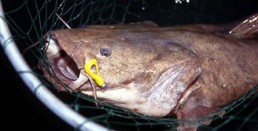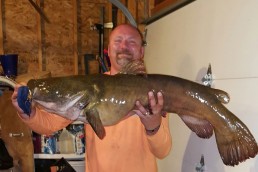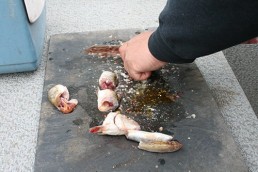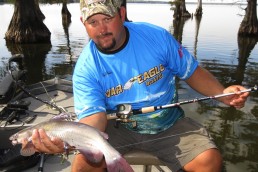Get Chummy and go Cattin’ Around
SHARE THIS POST
All major waterways in the Midwest contain exceptional catfish-catching opportunities. Here are some for your summer fishing enjoyment, down South in Tennessee. Keep in mind that most catfish species are spawning this month.
If you keep in mind that catfish hunker down close to cover just like bass do, you may fare better. Cats like the ledges, points and drops along the main channel of lakes, rivers and streams. These structures concentrate fish, whereas they tend to spread out on the flats where it’s often more miss than hit. They are willing to eat a variety of baits but you can’t go wrong using worms and cut bait, preferably skipjack. Most will hit minnows, especially flatheads—they love a living lunch.
Chummy cats
There are two ‘chummy’ ways to catch cats, natural and man-made. The natural way is to watch for gars feasting on shad. Catfish move under the surfacing gar to eat the leftovers. Gars tend to leave chunks of shad to filter down the water column. While most anglers get disgusted at seeing gar, this is the time for cat anglers to get chummy with them.
Some fishermen like canned or dry cat or dog food and dry catfish food made for use in ponds. From the bank or from a boat, you can chum an area by throwing out a handful from time to time. You want to attract the fish to your area but not feed them until they are full.
Dry catfish food pellets can be made more appealing by soaking them in chicken blood, water and scents, such as garlic, anise oil and commercial scents (Kodiak Scent, Fish Formula, etc.). Toss a couple of handfuls where you want to fish and give it 20 to 30 minutes to work.
You can make a catfish caller by punching holes in a 3-pound coffee, filling it with chum and placing a rock inside to make it sink. The catfish caller leaks into water, rivers and lakes. Tie a string to your can so you can retrieve it to use again and not litter.
Your catfish caller summons catfish in one at a time or by the schools. In a short time you should have a lot of fish interested. The more the merrier. The competition for food increases appetites and creates a feeding frenzy. All you have to do is bait your hook, put it in the water and reel in a fish.
Chumming every so often will keep catfish near you all day long. If you chum the same spot every day, you will increase the numbers of fish that will show up and you’ll stay chummy with the catfish. Choose your place and method and then enjoy some summer catfishing.
Midwest river action
Dams on Midwest rivers offer not only fast cat action but also big cats. Shad and skipjacks are your best bait selection because they are abundant and the cats are waiting for the injured ones to exit the turbines. If there is no current, anchor near a drop or depression and fish on the bottom.
Are you enjoying this post?
You can be among the first to get the latest info on where to go, what to use and how to use it!
From the bank, heavy equipment is needed to handle the current. A 4-ounce weight is required to keep your bait on bottom. Tie a three-way swivel to your 20-pound-test line—this is an ideal condition to use one of those braided lines. From the three-way, tie a 12- to 16-inch leader (of less strength than your main line; bell sinkers are a good choice) and a two-foot leader (same strength as your main line) for your 2/0 to 5/0 hook.
Put on a big hunk of skipjack or gizzard shad or several small threadfin shads. Cast close to the powerhouse and keep your line tight. When you see your rod tip bobbing with the hit, wait a few seconds for the cat to get the bait in its mouth, take up your line slack and then haul back on your rod hard. You have to pull your fish against the current to get a good hook-set.
It’s a good idea to have a drop net if you fish from the catwalks below these dams. You can lower the net to lift your catch and, if you have a small mesh net, it will work great for capturing shad or skippies for bait.
Catfishing from a boat opens other options to drift in the slow eddy water and the deep holes in the river channel farther downstream. Right below the turbine vents and the deep holes downstream are your best shots at cats weighing more than 10 pounds.
Reelfoot Lake
Catfish have been in this lake since the earthquake formed it two centuries ago. Its maximum depth is about 18 feet, and tight-lining bait in the deeper water will probably be more rewarding than fishing among the stumps and cypress knees, but don’t ignore that cover.
Kentucky Lake
Some years ago a ‘mystery fish’ was ‘almost’ caught in the Tennessee River below the Highway 70 bridge at New Johnsonville. The fish had been breaking saltwater rods, stripping gears out of reels and generally wrecking equipment. Finally a huge cat was caught and this was thought to be the mystery fish.
A month later there was another fish below the bridge tearing up equipment again. One angler hooked it and the fish pulled his boat to Bird Song Creek before breaking his line. Bird Song is upstream about three miles from the bridge.
You trophy anglers who are looking to break a record (or your arm) should take your stoutest gear to fish under and just below the bridge. Meanwhile, if you are looking to catch a lot of catfish between pan-sized and 5 pounds, drift nightcrawlers, shrimp, liver, shad or stinkbaits along the main channel flats and at and below the lip of the channel drop. Drifting at the mouths of creeks usually pays off well, too.
No matter which lakes or rivers you fish, there’s a dang good chance catfish swim there. Small species like bullheads or behemoths like blues or flatheads can feed you and your family, plus provide a good day in the outdoors. When you’re lucky, you get a big’un and big thrill.
MWO
SHARE THIS POST
Did you enjoy this post?
You can be among the first to get the latest info on where to go, what to use and how to use it!
Vernon Summerlin
For more than 30 years, Vernon Summerlin has produced outdoor articles and books that can be found on Amazon; most recently How to Analyze a Bass Hole: Think and Catch’em! He is the recipient of more than 40 awards for magazine and newspaper articles, TV, radio, photography and books.



